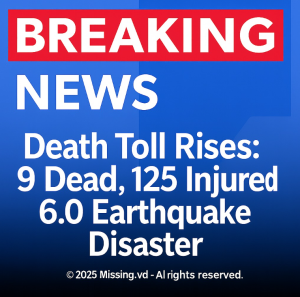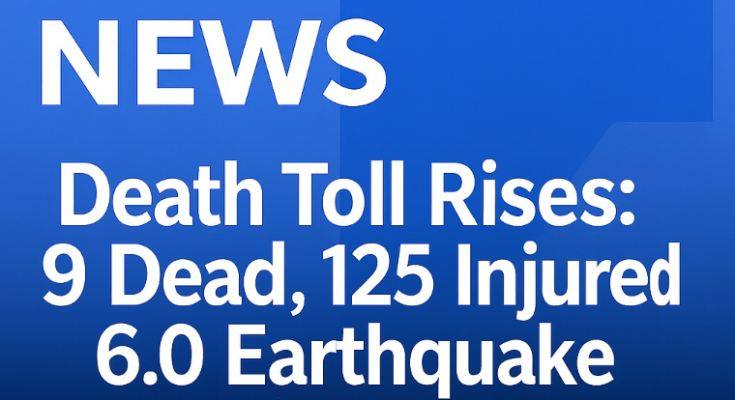The Night the Mountains Trembled: Afghanistan’s 6.0 Magnitude Earthquake
On the night of September 1, 2025, the earth groaned beneath the Hindu Kush mountains, and in a matter of seconds, life changed irrevocably for thousands in eastern Afghanistan. At precisely 11:47 p.m. local time, a powerful 6.0 magnitude earthquake struck near Jalalabad in Nangarhar province, close to the Pakistan border. The tremor, shallow at just 8 kilometers deep, unleashed devastation across the rugged terrain of Kunar and Nangarhar provinces, leveling villages, burying families, and plunging the region into chaos.
A Shattered Silence
The quake’s epicenter lay just 17 miles east of Jalalabad, a city already strained by years of conflict and economic hardship. In the remote village of Maza Dara in Kunar’s Nurgal district, Sadiqullah, a father of five, was jolted awake by what he described as a “deep boom, like a storm crashing through the mountains.” He rushed to his children’s room and managed to pull three of them to safety before the walls collapsed around him. Trapped under rubble for hours, he was eventually rescued—but his wife and two sons did not survive.
Stories like Sadiqullah’s echoed across the region. In Wadir, another village in Kunar, Obaidullah Stoman arrived to search for a missing friend. “There is only rubble left,” he said, overwhelmed by the destruction. Entire communities were reduced to dust and stone, their homes—often built from mud bricks—no match for the quake’s force.
The Human Toll
By dawn, the scale of the disaster began to emerge. Initial reports estimated hundreds dead, but the numbers climbed rapidly. As of September 2, the Taliban government confirmed over 1,400 fatalities and more than 3,000 injuries in Kunar alone. Nangarhar province reported additional casualties, with dozens dead and hundreds wounded. The United Nations warned that the quake could affect “hundreds of thousands,” especially in isolated areas where access to aid was nearly impossible.
Hospitals in Jalalabad and Kabul were overwhelmed. Medical teams worked around the clock, treating crush injuries, broken limbs, and trauma. Helicopters ferried the wounded from inaccessible villages, while survivors dug through debris with bare hands, searching for loved ones. In many places, the dead were wrapped in white shrouds and buried in mass graves, their names known only to grieving families.
A Nation Already on the Brink
Afghanistan’s vulnerability to natural disasters is compounded by decades of war, poverty, and political instability. Since the Taliban’s return to power in 2021, foreign aid has dwindled. The United States, once the largest donor, slashed funding in early 2025 following a change in administration. The United Nations, facing historic budget cuts, announced it would scale back humanitarian operations globally, leaving Afghanistan with fewer lifelines.
The quake struck a nation already grappling with a humanitarian crisis. Millions of Afghans had been forcibly returned from neighboring countries, and food insecurity plagued vast swaths of the population. The destruction of homes, schools, and clinics only deepened the suffering. “We need help here,” pleaded one villager. “There is no one who can come and remove dead bodies from under the rubble”.
The Response: Local Courage, Global Silence
In the immediate aftermath, Taliban officials mobilized rescue teams and appealed for international assistance. Interior ministry spokesperson Abdul Matin Qani said all available resources were being deployed—from security forces to medical personnel and food supplies. Yet, despite the urgency, foreign governments were slow to respond. India sent 1,000 family tents and promised additional aid, while China expressed willingness to help. But many others remained silent.
Local residents became first responders. In villages like Sholt, Arit, and Mamagal, survivors formed human chains to clear debris, carry the injured, and comfort the grieving. Their resilience was extraordinary, but the scale of the disaster demanded more than courage—it required coordinated global support.
Echoes of the Past
This was not Afghanistan’s first deadly quake. In October 2023, a 6.3 magnitude earthquake killed thousands, and in June 2022, a 5.9 magnitude tremor claimed over 1,000 lives. Each time, the pattern repeated: devastation, inadequate aid, and forgotten promises. The September 2025 quake was yet another reminder of the country’s seismic fragility and the urgent need for disaster preparedness.
A Call for Compassion
As the dust settles, the question remains: will the world respond? The United Nations pledged an initial $5 million and promised to assess further needs. But for families like Sadiqullah’s, no amount of money can restore what was lost. What they need now is solidarity—medical aid, shelter, food, and the assurance that they are not alone.
This earthquake was not just a geological event; it was a human tragedy. It exposed the fault lines not only beneath the earth but within our global conscience. Afghanistan may be distant, its politics complex, but its people are no less deserving of empathy and action.
Final Thoughts
In the quiet hours after the quake, as villagers lit candles for the dead and prayed for the missing, the mountains stood still once more. But beneath that silence lies a plea—for recognition, for help, for hope. The tremors may have ceased, but the aftershocks of grief and resilience will echo for years to come.
If you’d like, I can help craft a follow-up story from the perspective of a survivor, a rescuer, or even a child caught in the chaos. Just say the word.

